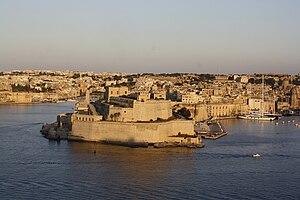| Battle of Malta | |||||||
|---|---|---|---|---|---|---|---|
| Part of War of the Sicilian Vespers | |||||||
 The Castello del Mare (modern day Fort Saint Angelo), seen from Valletta. The castle has undergone many renovations and re-modellings since the 13th century. | |||||||
| |||||||
| Belligerents | |||||||
| Crown of Aragon |
| ||||||
| Commanders and leaders | |||||||
| Roger of Lauria |
Bartholomé Bonvin | ||||||
| Strength | |||||||
|
18–21 galleys 5,500 men |
19–22 galleys 7,800 men | ||||||
| Casualties and losses | |||||||
|
300 men dead 200 men injured |
3,500 men dead 860 men prisoners 10 galleys captured 2 galleys scuttled | ||||||
The Battle of Malta took place on 8 July[n 1] 1283 in the entrance to the Grand Harbour, the principal harbour of Malta, as part of the War of the Sicilian Vespers. An Aragonese fleet of galleys, commanded by Roger of Lauria, attacked and defeated a fleet of Angevin galleys commanded by Guillaume Cornut and Bartholomé Bonvin.[2][3]
The Angevin ships arrived in Malta first, and proceeded to relieve the Angevin garrison, which was besieged within the walls of the Castello del Mare. The galleys were followed in close pursuit by an Aragonese fleet. Lauria drew the Angevin-Provençal fleet into a battle, and destroyed almost all of Cornut and Bonvin's vessels.[4] The defeat forced Charles I of Naples to postpone his plan to invade Sicily.[5]
- ^ Gwatkin, Henry Melville (1929). The Cambridge Medieval History. Vol. VI. Cambridge, United Kingdom: Macmillan. p. 199.
- ^ DeVries, Kelly (2004). Battles of the Medieval World. New York: Barnes & Noble. ISBN 0-7607-7779-9.
- ^ Carr, M. (2015). Merchant Crusaders in the Aegean, 1291–1352. Boydell & Brewer. p. 85. ISBN 9781843839903.
- ^ Runciman, S. (2012). The Sicilian Vespers: A History of the Mediterranean World in the Later Thirteenth Century. United Kingdom: Cambridge University Press. p. 244. ISBN 9781107604742.
- ^ Pryor, J.H. (2008). France, J. (ed.). Mercenaries and Paid Men: The Mercenary Identity in the Middle Ages : Proceedings of a Conference Held at University of Wales, Swansea, 7th–9th July 2005. United Kingdom: Brill. p. 128. ISBN 9789004164475.
Cite error: There are <ref group=n> tags on this page, but the references will not show without a {{reflist|group=n}} template (see the help page).